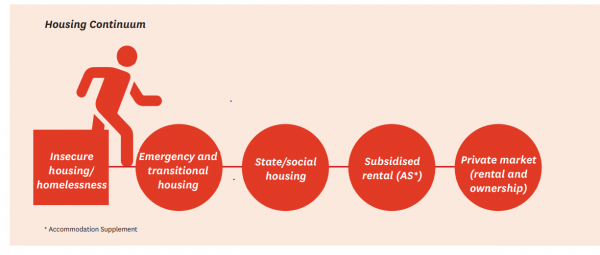
What is a CHP?
Since 2014/15 there has been an increase of Community Housing Providers (CHPs) tasked with the same role as Kainga Ora – the placement of people from the Social Housing register into homes, provision of support. Individuals and whānau in Public Housing places are eligible for Income Related Rent (IRR) which is generally 25% of their income.
CHPs then receive Income Related Rent Subsidy (IRRS) which is the payment to then from the Government to cover the difference between the income-related rent paid by a tenant and what rental the market would pay. CHPs housing stock is a combination of leased Kainga Ora places, leased from private owners, own new builds, or long term leased new builds.
CHPs have a rigorous registration and monitoring process via the Community Housing Regulatory Authority (CHRA). CHPs are Social Landlords who do all the normal property management functions and work within the Residential Tenancies Act but offer much more in terms of navigating to other supports and helping to sustain tenancies. Guidance-Note-Class-1-Social-Landlord.pdf (hud.govt.nz)
You can see a list of all CHPs registered across NZ here: The CHRA register | Community Housing Regulatory Authority (hud.govt.nz).
The Housing Continuum

The illustration above shows a simplified progression along the housing continuum. Not all people on the Social Housing Register move through each stage of the continuum. Some go straight into state/social housing and some with housing need access to the private market with Accommodation Supplements.
The Government is currently reducing its dependency on emergency accommodation in terms of motels and is increasing transitional housing. The challenge is that transitional housing is generally for a period of 3 months with still limited options moving out of transitional housing. Currently, the Government’s per-day spend on emergency and transitional housing is $1m.
The Social Housing Register
People with a housing need apply to MSD/WINZ via the Social Housing Register. There are 3 main parts to this:
- Screening – to determine potential eligibility (mainly over the phone, and some of this information may be already held by MSD).
- Assessment – requires an appointment. Tests eligibility and assesses the housing need based on the current Social Allocation System criteria. (SAS)
- Waitlist – if eligible, a client is given a priority rating based on the SAS criteria and put on the waitlist for a house.
Once on the register, people are given a "need score" out of 20 (20 being the highest need) and a priority category (A for high priority and B for lower priority). This is intended to ensure that people with the greatest need are housed as quickly as possible.
CHPs and other agencies support people with the screening and assessment.
What is important are endorsements from clinicians GPs and support staff to highlight why this person needs a house and the difference it will make to mental health and wellness. This most often increases their priority rating on the register.
To give an indication of need in just the Wellington region for the period ended 31 December 2020:

2075 individuals and whanau requiring housing with 54% being assessed as requiring a 1 Bedroom property.
In terms of supply Kainga Ora’s current stock to 31 December was:

Only 12% of KO stock are 1 bedroom. However, KO is building at pace and scale, but we continue to see increased demand on the register every month.
Want to know more?
- https://chra.hud.govt.nz/ this is a link to CHRA- this is Community Housing Regulatory Authority which was under MBIE and is now contained within HUD. Look here for what a social landlord is and who are CHP’s.
- Public-Housing-Plan-2021-2024-web.pdf (hud.govt.nz). Govt's intention as to how many and where new places
- https://www.hud.govt.nz/community-and-public-housing/ HUD’s website that also lists regional factsheets for each region.
- Homelessness Action Plan (hud.govt.nz) The Govts homelessness Action plan
- https://www.tenancy.govt.nz/ Tenancy Services website
- Housing Register - Ministry of Social Development (msd.govt.nz) MSD’s SH register stats